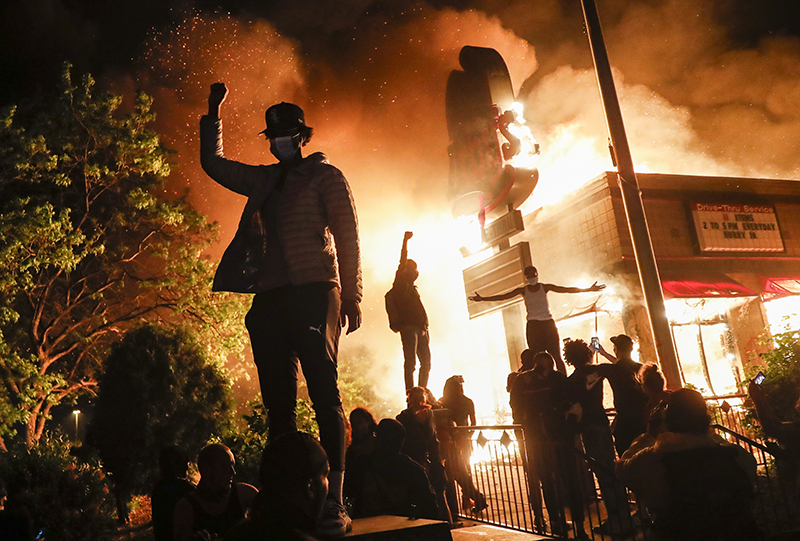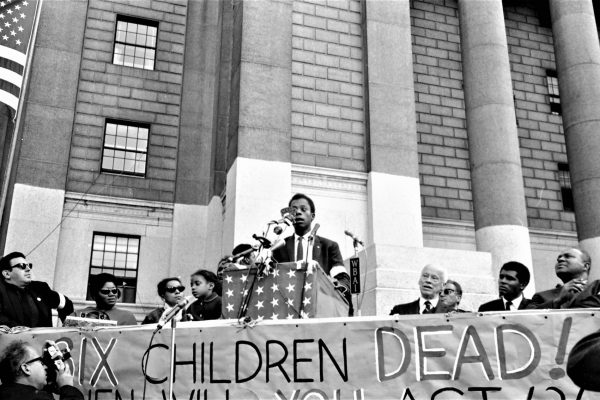Thursday evening, protestors in Minneapolis seized the city police’s third precinct building and set fire to it. The immediate cause of the flames is a devastating incident of state violence with deep historical roots: on Monday, a white police officer jammed his knee into the neck of George Floyd, a black resident, for several minutes as three other officers held Floyd’s body down on the street. In his final moments, Floyd—unarmed and in handcuffs—pled for his life and repeatedly informed the officer and the crowd of bystanders that he couldn’t breathe.
It can be a struggle to imagine some of the most overpoliced, marginalized, and isolated Americans as political actors.
Minneapolis residents have become all too familiar with this type of premature death. The city has been rocked by officer-involved shootings in recent years and subsequent protest. In 2015 two Minneapolis police officers faced no repercussions for shooting and killing Jamar Clark, a twenty-four-year-old black man. In 2016 police killed Philando Castile, a thirty-two-year-old black man, in nearby Falcon Heights, an encounter that was captured on social media and received national attention. A jury ultimately acquitted the officer who took Castile’s life, but it’s not as if Minneapolis police are completely above the law. A black Minneapolis officer killed a forty-year-old white woman in 2017 and is currently serving a twelve-and-a-half-year sentence in prison.
Thousands took to the streets in peaceful protest the night after Floyd died, demanding justice for his life. Demanding that, this time, the officers involved be held fully accountable for their actions. By Wednesday none of the officers involved in Floyd’s death faced criminal charges. Authorities have so far declined to prosecute any of the four men.
Minneapolis residents, in turn, responded to the buildup of unanswered grievances and the lack of concrete changes to their immediate living conditions—problems of under-protection, intentional segregation, and structural exclusion that have only been exacerbated by COVID-19—by using the available resources at their disposal: throwing rocks, bricks, bottles, and Molotov cocktails at buildings, police precincts, and police cruisers; and by taking goods and food from major retailers such as Target and AutoZone, and then burning these and other institutions to the ground. Police have unleashed tear gas and rubber bullets on protesters in response, and the National Guard has been deployed. Although some protest in the city remains peaceful, and has spread to Memphis, Los Angeles, New York, Chicago, Birmingham, and other major cities, Minneapolis continues to burn.
These types of uprisings have been a nearly perennial occurrence in the United States for more than fifty years. In the month following the assassination of Martin Luther King, Jr., black uprisings erupted in more than 125 cities, leading to 50 deaths and more than 15,000 arrests. In the years that followed (1968–72), at least 960 segregated black communities witnessed 2,310 separate incidents of what journalists and state security officials described as “disturbances,” “uprisings,” “rebellions,” “melees,” “eruptions,” or “riots.” As in Minneapolis today, this type of collective violence almost always started with contact between residents and the frontline representatives of the state—the police—and then quickly moved to other institutions. Indeed, following King’s murder, many black residents in cities across the United States responded to the process of criminalization and unanswered calls for greater socioeconomic inclusion by throwing rocks and punches at police officers, detonating firebombs, and plundering local stores.
With his embrace of “Law and Order” politics, Trump continues a long tradition of seeking to manage the material consequences of socioeconomic problems with more police, more surveillance, and more incarceration.
Although this period of unrest remains marked in many people’s memories of the period, it was hardly the beginning of violent urban uprising by black Americans. In fact, U.S. cities had been beset with black rebellion since the enactment of the Civil Rights Act of 1964. Federal policymakers and officials blamed this earlier period of disorders (and the hundreds of millions of dollars in property damage it caused) primarily on the behavior of young black men. They sought to address it as a criminal problem, launching the War on Crime and passing the Omnibus Crime Control and Safe Streets Act of 1968, which incentivized increased local policing and surveillance of black urban areas, as well as formal “riot control” training. However, a proper understanding of sixties-era urban rebellion—and similar rebellions now—depends on our ability to interpret it not as a wave of criminality, but as a period of sustained political violence.
Arguably, the success of King’s brand of nonviolent direct political action—so often valorized by pundits over and against “destructive” “rioting”—depended on the presence of this violent direct political action. As King recognized, the coercive power of mass nonviolence arose in part from its ability to suggest the possibility of violent resistance should demands not be met. Therefore, we should endeavor to see violent and nonviolent expressions of black protest as entwined forces that shaped the decade. In addition, and more challenging perhaps, we should attempt to understand violent rebellion on its own terms, as a form of direct political action that was just as integral to the decade.
It can be a struggle to imagine some of the most overpoliced, marginalized, and isolated Americans as political actors, and this bias has influenced the writing of history. Even those of us interested in forms of resistance to structural racism have been reluctant to take seriously the political nature of midcentury black uprisings. Yet they were neither spontaneous nor “meaningless” eruptions. Just as much as nonviolent direct action, rebellion presented a way for the oppressed and disenfranchised to express collective solidarity in the face of punitive state forces, exploitative institutions, and calcified “democratic” institutions.
Reviving our knowledge of midcentury violent rebellion against police and state forces also has important ramifications on how we tell the history of the rise of mass incarceration. Some scholars of the rise of the carceral state, including Michael Javen Fortner and James Forman, Jr., have recently argued that black Americans called for more police on the streets, at schools, and in housing projects. These accounts, implicitly or explicitly, suggest that black Americans championed the politics of law and order and are therefore partly to blame for the punitive turn in domestic policy. But the history of the forgotten rebellions adds another, dynamic layer and set of actors to the story of the so-called “black silent majority.” As much as some segments of the black middle class, political leaders, and clergy joined the clamor for “law and order,” many others—who do not appear in traditional archives and many of whom were too young to vote—collectively defied the legitimacy of new policing and carceral strategies.
In addition to the failure to attend to the voices of African Americans across class strata and outside of traditional archives, a crucial part of the story of how these rebellions became obscured in our memory is bureaucratic. By the late sixties, President Lyndon Johnson’s Safe Streets Act and the subsequent militarization of local police effectively quashed any nascent movement of political rebellions by making them matters of local administration and pacification instead of national political crises. The legislation established an unprecedented $330 million federal investment in crime control that effectively began the process of militarizing local police forces operating in communities that seemed vulnerable to rebellion with surplus weapons from Vietnam, and training them in systematic riot control methods—a playbook that would be copied almost exactly after 9/11. The act essentially created the infrastructure and punitive apparatus to make smaller police departments—particularly those in deindustrializing cities with a critical mass of black residents—capable of handling uprisings on their own before they became spectacular enough to generate national media or activist attention.
Near the end of his life, King observed that “social justice and progress are the absolute guarantors of riot prevention.”
Unfortunately, the unrest in Minneapolis reminds us that this legacy is still very much with us. Rather than responding to violent political rebellion with policy—such as addressing mass unemployment, failing public schools, and inhumane housing conditions—policymakers and officials, from Richard Nixon’s War on Crime to the bipartisan War on Drugs to Donald Trump’s embrace of “Law and Order” politics, have consistently sought to manage the material consequences of socioeconomic problems (e.g., urban decay and drug abuse) with more police, more surveillance, and, eventually, more incarceration. We as a nation still fail to reckon with the wisdom King prophetically offered toward the end of his life: that only “social justice and progress are the absolute guarantors of riot prevention. There is no other answer. Constructive social change will bring certain tranquility; evasions will merely encourage turmoil.”
Echoing King roughly fifty years later, Minneapolis NAACP president Leslie Raymond reflected on the city’s disturbance to a reporter: “We know we need systemic reform and change. So what does that look like? Resources need to be poured into the African American community. . . . The system often does it wrong, and the black community really needs to be the decision-maker at the table and be given proper resources.” And as the unrest continues to unfold, City Council vice president Andrea Jenkins—the first openly transgender black woman to be elected to public office in the United States—called for racism in the city to be treated as a public health emergency. Until the structural roots of collective violence are addressed as King indicated a half century ago, and Raymond and Jenkins join thousands of protesters in calling for today, spiraling tensions and distrust between police officers and the racially marginalized citizens they are charged with protecting will remain. Indeed, COVID-19 has exacerbated another deadly virus that caused Floyd’s death and has been killing the United States for centuries: racism.








